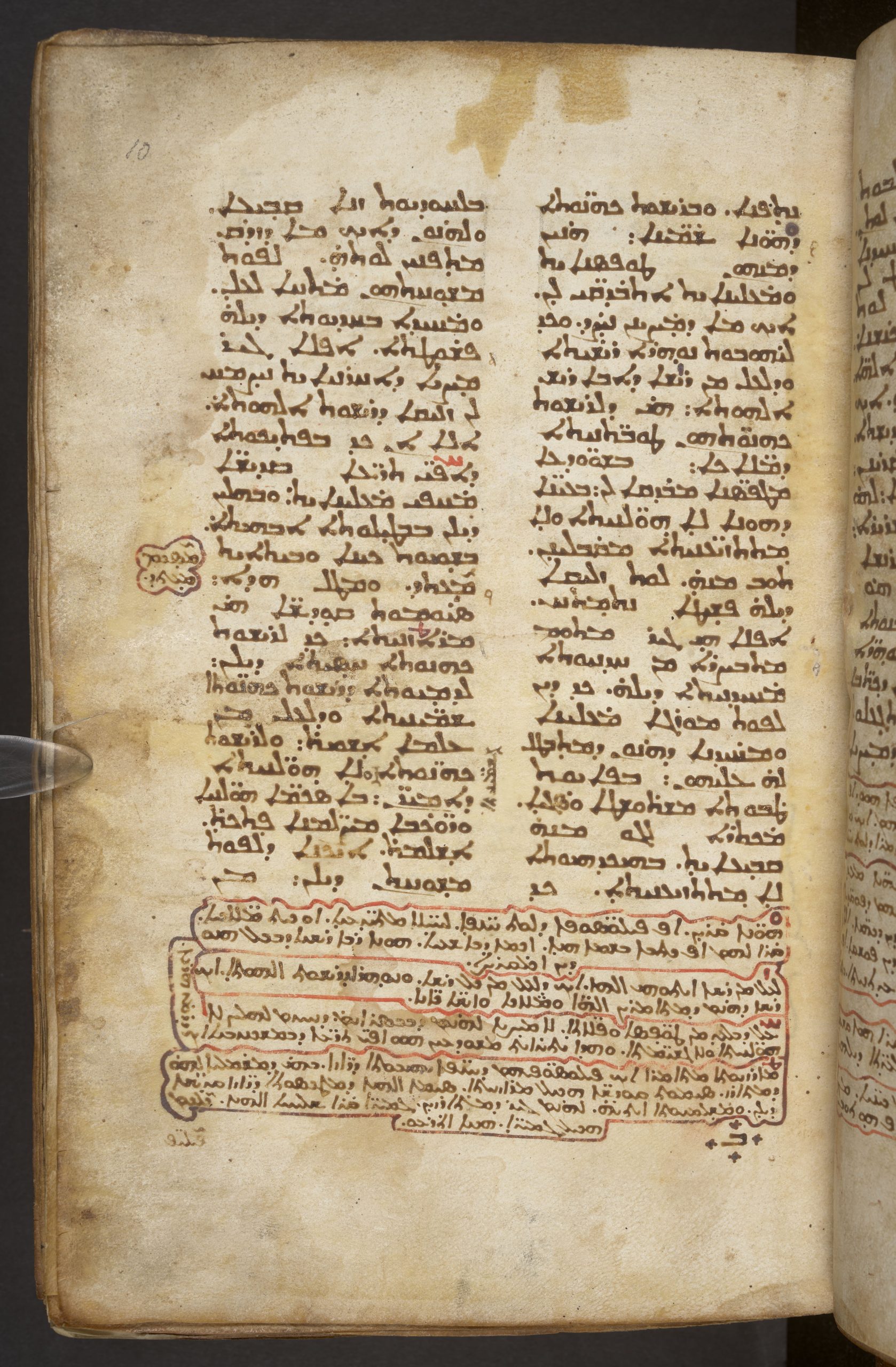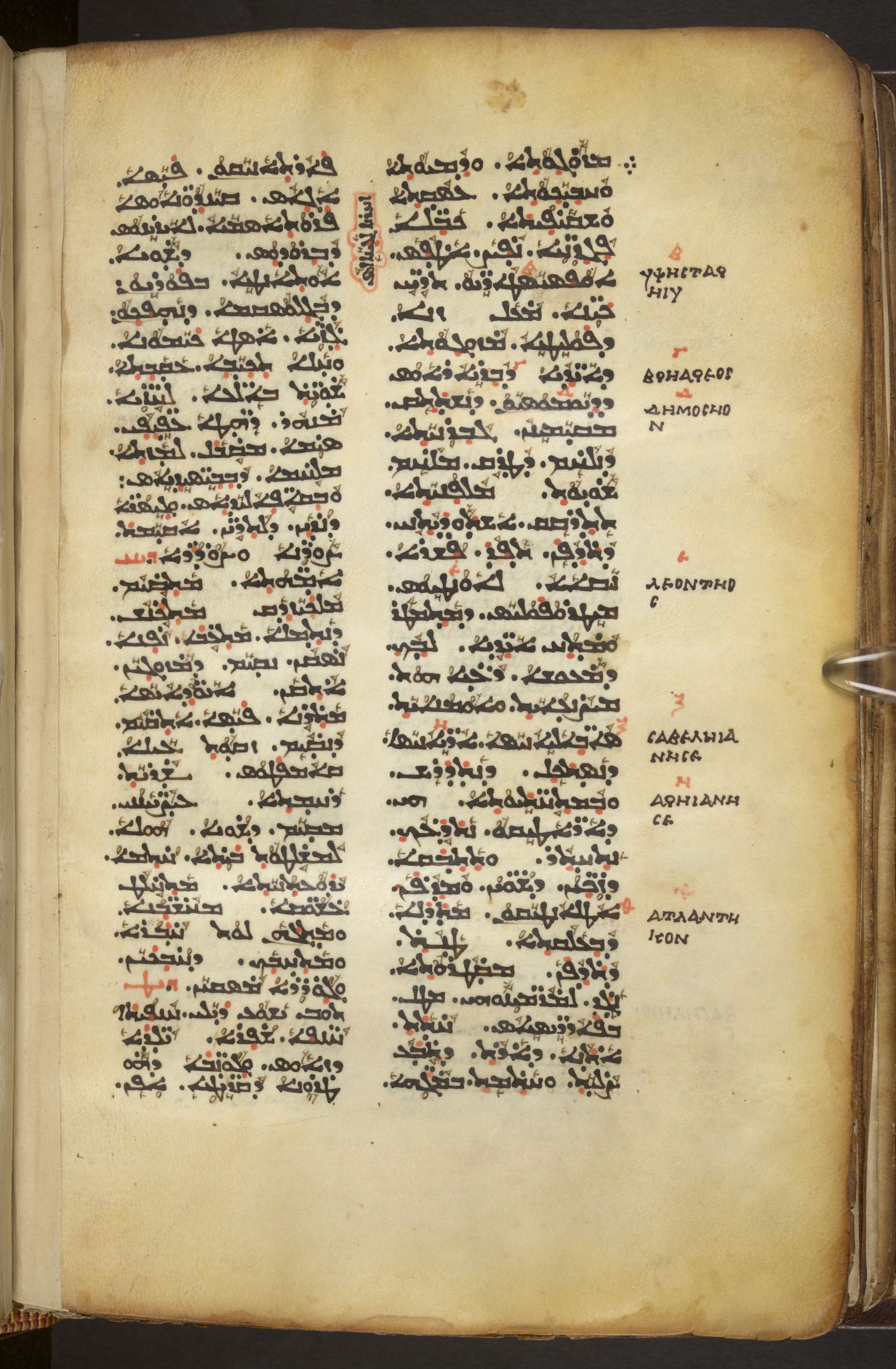In the month of Ramaḍān 253 AH (September/October 867 CE), Bishr ibn al-Sirrī finalized in Damascus his work on translating the Pauline Epistles from Syriac into Arabic, annotating and transcribing them into a manuscript. On a different occasion, he prepared another manuscript where he did the same for the Acts of the Apostles and the Catholic Epistles. These two manuscripts circulated separately for a while, yet at some point they were restored by replacing lost leaves and combined to form what is now known as MS Sinai, Arabic 151 (S151), currently housed in St. Catherine’s Monastery, Sinai, Egypt.[1] Reflecting the Syriac tradition, the Pauline Epistles represent a single corpus divided into 55 chapters. Similarly, Acts and the Catholic Epistles form one unit that is divided into 32 chapters.
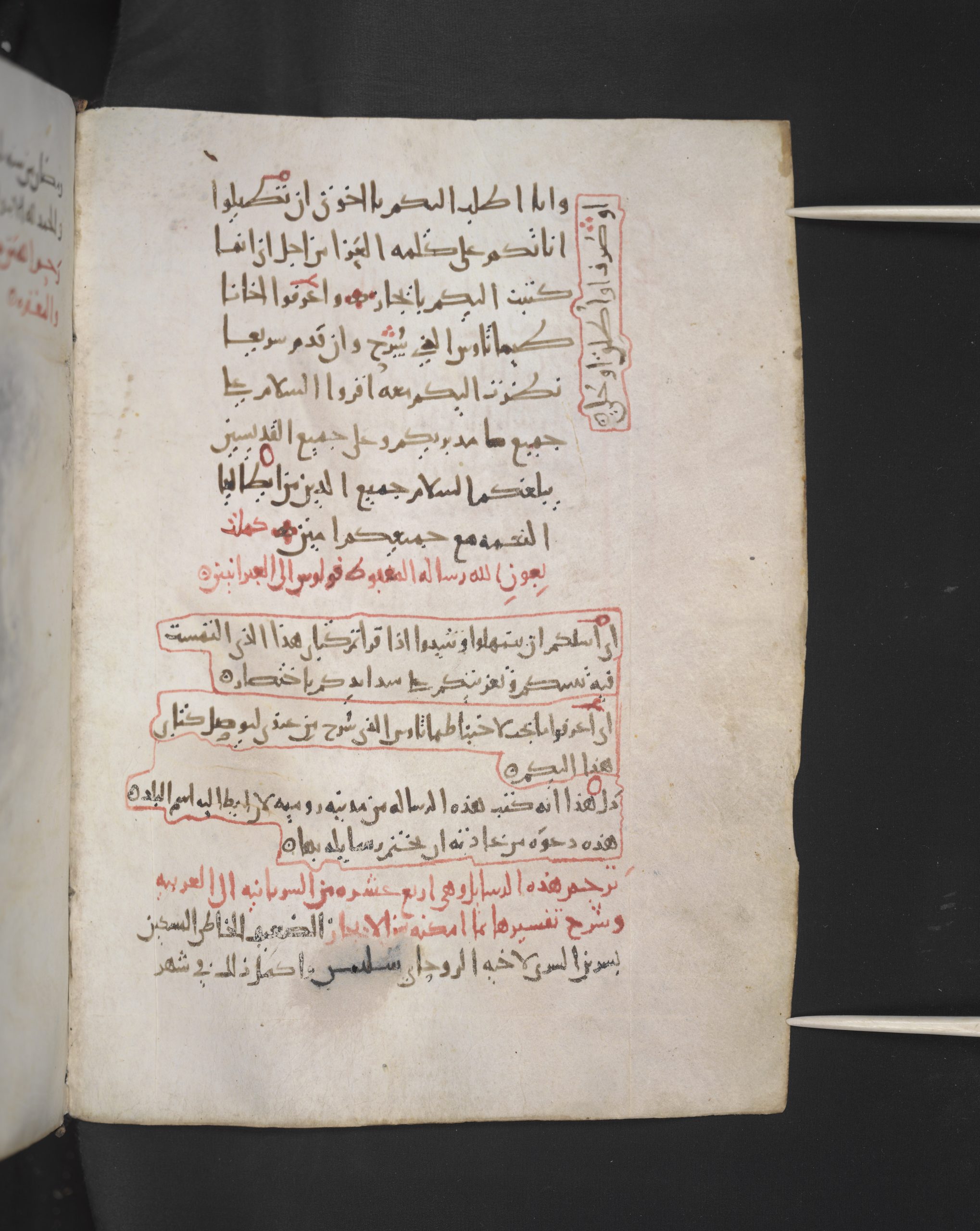
Photograph courtesy of Saint Catherine’s Monastery, Sinai, Egypt.
In addition to its status as the earliest dated manuscript of the Arabic Bible, S151 exhibits other significant features; of particular interest to this blog is its layout. The text of S151 encompasses the biblical text in addition to annotations and glosses which provide short interpretations of select words/verses in the biblical text. The scribe, Bishr, arranged the mise-en-page so as to distinguish the biblical text from its annotations. The biblical text usually occupies the upper part of the page in shorter lines and larger letters with more space in between. By contrast, the annotations appear in longer and denser lines below and in somewhat smaller letters than the biblical text. Within the ruled writing blocks, the actual area occupied by the script varies due to the previously mentioned difference between the biblical and the annotation sections.
Bishr, as a translator, interpreter, and scribe, at the same time had several challenges in organizing the space on the page to his needs. Naturally he wanted to keep every biblical verse along with its annotations on the same page, but this was not always feasible due to the increased number of the annotations and the length of some of them. This led him, in some cases, to continue the annotations on the next page, or more likely to write them vertically in the larger margins around the biblical text. The annotations are occasionally framed in red to distinguish them from each other and from the biblical text. Had Bishr been content with this, every page of S151 would have been occupied by a biblical text randomly surrounded by horizontal and vertical lines. A reader would have been lost trying to identify which annotation was connected to which biblical word/verse. However, Bishr used a system of red reference marks to connect each annotation to its respective biblical word in the main text. Some of these marks are usually known as signes-de-renvoi and they include dots, dashes, arrows in different directions, infinity marks, and a combination of all of them that are sometimes hard to name.[2] Although Bishr was working on an Arabic text translated from Syriac, he employed no Arabic or Syriac letters in his reference marks, nor did he use any numerals. He mostly used signes-de-renvoi in addition to a few Greek letters and some Latin letter shapes. On average, five to seven marks are found on each page. While some marks barely appear in the manuscript, others were frequently used on successive pages. Logically, one reference mark indicates one annotation per page, except in rare cases when the scribe used the same mark twice to surround the phrase he was annotating.
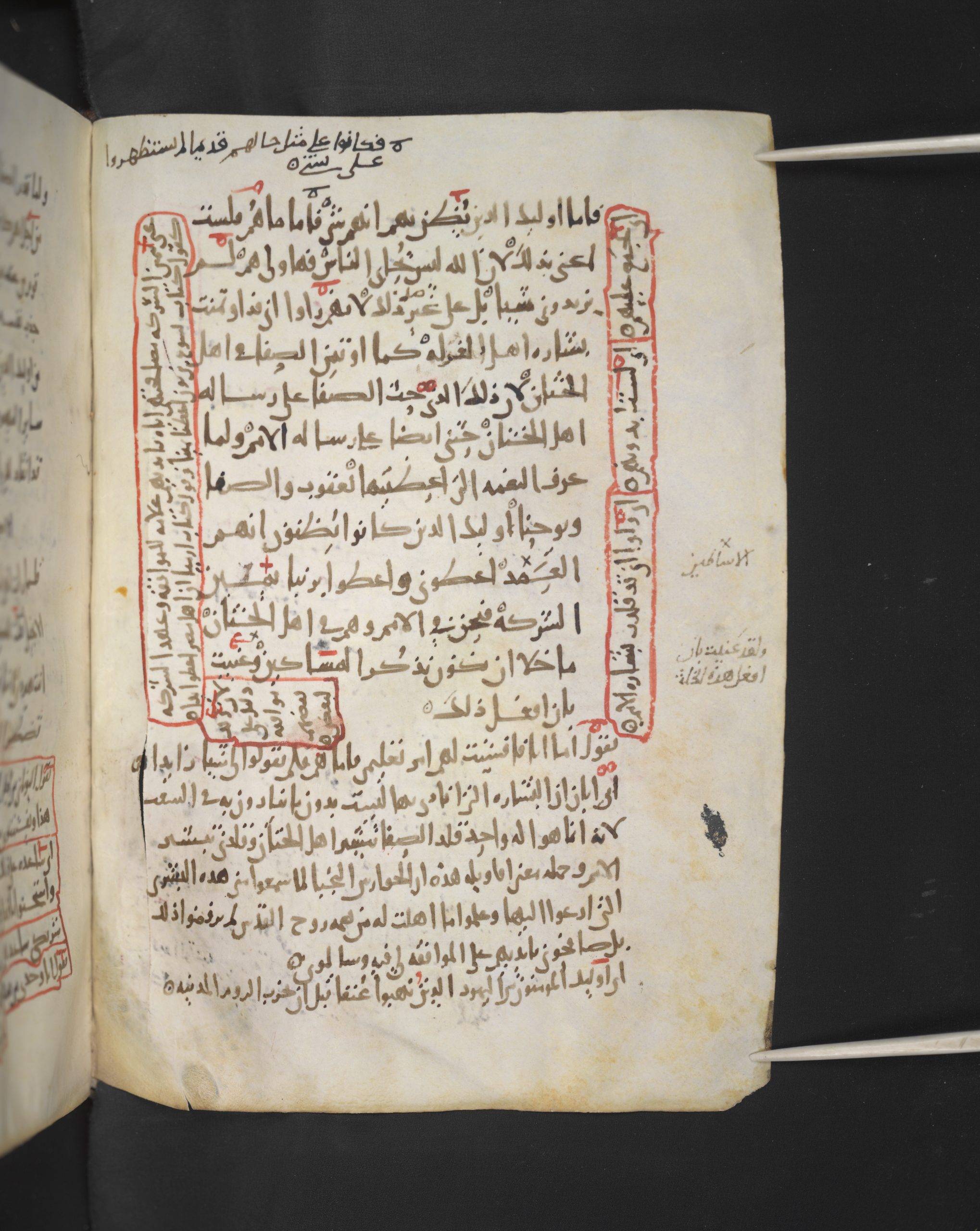
Photograph courtesy of Saint Catherine’s Monastery, Sinai, Egypt.
If we are to imagine the strategy Bishr followed in each page, we realize it was not an easy task. The first and easiest strategy, albeit daunting and time consuming, could be that he made the annotations one by one along the way as he was transcribing the biblical text. If this were true, the page would have been more organized and adjusted to host the biblical text and its annotations. But the layout is somewhat chaotic, with the annotations dispersed all over the page. The second and more plausible strategy is that he transcribed the biblical verses on a given page, estimating how much space would be needed for the annotations, and keeping that space empty for these purposes. Once he finished the biblical text, he would transcribe the annotations, writing them first below the biblical text and, once the space was filled, he would transcribe the rest of the annotations vertically or on the next page if needed. After finishing them, he would turn to use his red calamus (the same one used for the colophon and rubrics) to distribute the signs over the main text and the respective annotations. Considering the chaotic state of the page, this strategy seems more likely.
Later readers of S151 imitated Bishr’s style, adding more signs and writing some glosses in the margins as well. Those later signs are, however, easily distinguished from Bishr’s signs as they were made in black ink, and the glosses they refer to are written in a different hand.
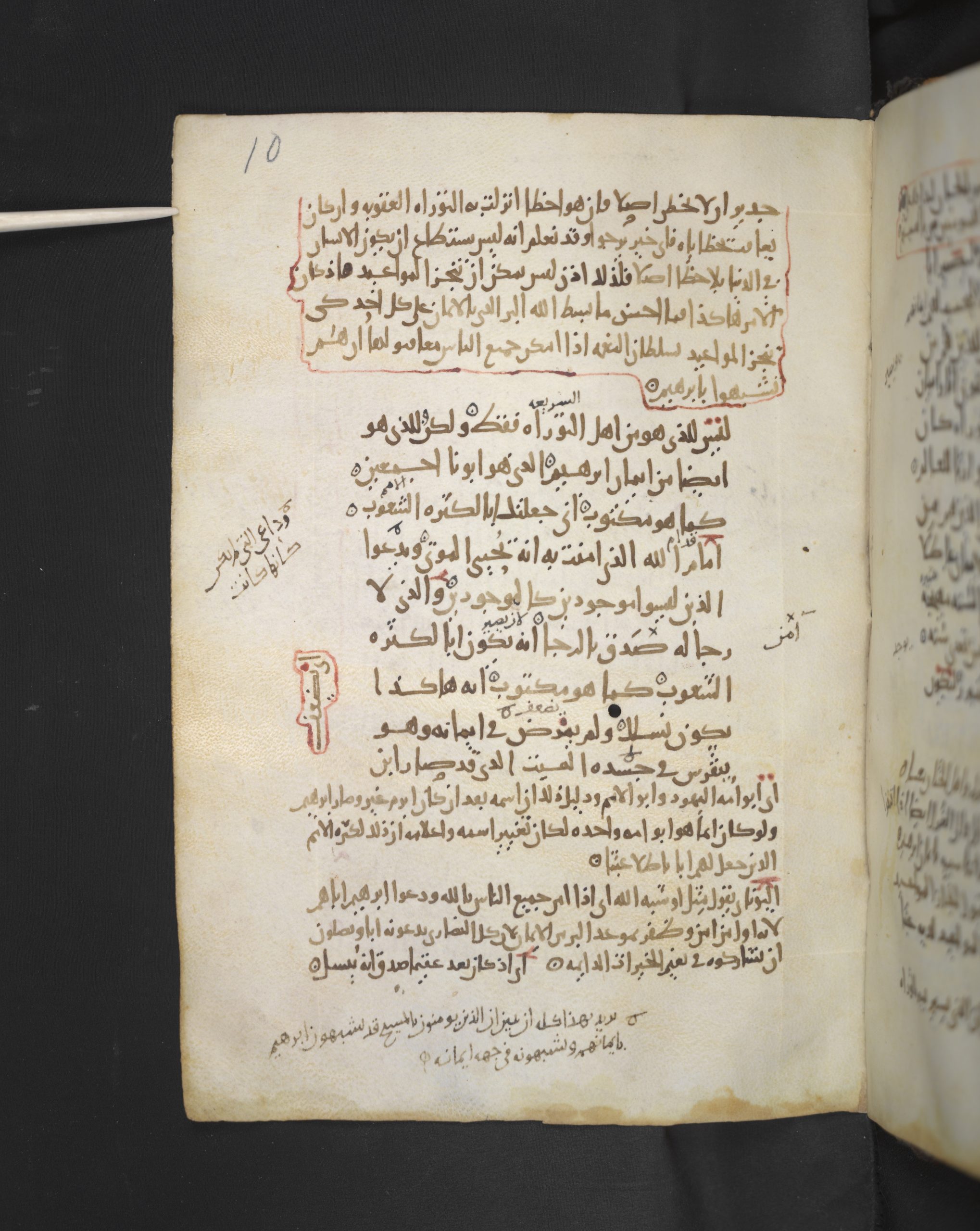
Photograph courtesy of Saint Catherine’s Monastery, Sinai, Egypt.
A question that comes to mind is related to the source of these reference marks and how Bishr learned about them. Across the centuries, marks designated omissions, lacunae, conjectures, corrections, quotes, or variant readings in manuscripts. Historically, using signes-de-renvoi in manuscripts goes back to the Alexandrian librarians, in particular Aristarchus, from whom the signs system gained its name as the Aristarchian signs. At the beginning, each sign performed a specific function in the text: for instance, an obelus marked a line considered suspicious, while the asterisk marked a repeated line in the text.[3] Through time, more signs were added whose meaning was not as fixed as the early signs. Even those that had a precise meaning when they first appeared gained different meanings with usage by different scholars. Origen, for instance, used the obelus to express the text that was present in the LXX but not in the Hebrew Bible, which is completely different from its original use.[4]
Looking into other traditions that might have influenced Bishr, Muslim scribes also employed these marks, mostly letters, in the form of abbreviations, logographs, or contractions. For instance, the letter ʻayn referred to ‘uriḍa, or “collated”, ṣaḥḥa for “corrected”, and so on. To a much lesser extent, numerals and signes-de-renvoi were used in the same tradition.[5] Their use, however, was occasional and, to the best of my knowledge, it was not as systematic and extensive as in the case of S151. This is noticeable in the commentaries, which are a popular genre in the Islamic tradition. It is common to find long comments in the margins tightly surrounding a text in horizontal, vertical, or even diagonal lines without reference marks.[6]
The most well-known systematic and extensive use of marks in Christian Arabic manuscripts came long after the time of Bishr. The thirteenth-century Coptic scholar Hibat Allāh ibn al-‘Assāl, in his critical version of the Gospels, prepared a famous list of marks.[7] He used only letters, alone or in combination, to express the different languages in which variant readings existed (or the lack thereof). While the letter qāf meant qibṭī or “Coptic”, sīn meant suryānī or “Syriac”, and so on. The list of Hibat Allāh was lengthy and complicated, and his marks survived only in a few copies of his Gospels.[8] Later, Christian Arabic scribes continued to employ the simplest abbreviations like the letters mentioned above, and abandoned the more complicated ones.[9]
This leaves the question as to which tradition Bishr relied on. It seems that Syriac is the most likely source of Bishr’s marks, since his work is a translation from a Syriac original. It is possible that these signs are part of the exemplar and that he copied them; however, this exemplar is so far anonymous. Among the vast corpus of Syriac manuscripts extant today all over the world, reference marks are not that common, at least not to this extent.[10] Some biblical texts and other manuscripts were suggested to me as a more probable place in which to search for these marks. Skimming some manuscripts of the Harklean text of the Gospels such as MS London, BL, Add. 7163, some variant readings can be found, but barely any reference marks. Variant readings were usually written above or very close to the word they refer to in the main text, which makes marks unnecessary.[11]
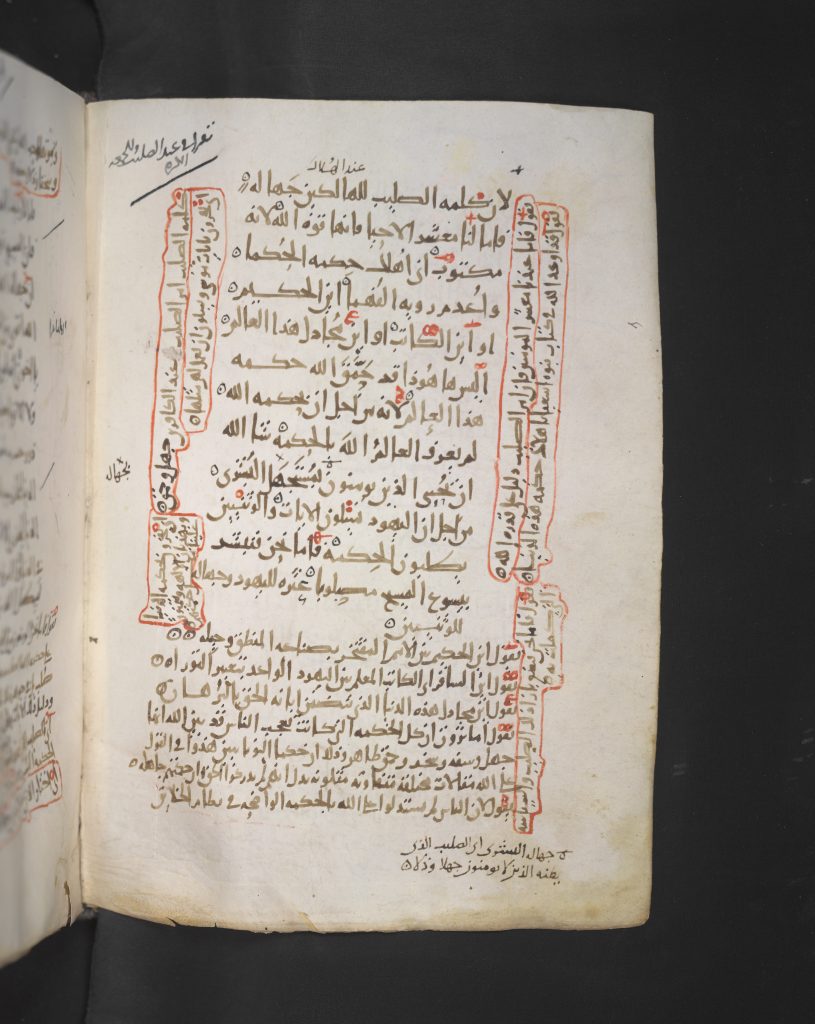
Photograph courtesy of Saint Catherine’s Monastery, Sinai, Egypt.
One of the Syriac texts that is comparable to S151 in terms of the extensive annotations and marks is the oeuvre of Dionysius the Areopagite in MS London, BL, Add. 12152 (837 CE).[12] The text is well organized in two equal columns in terms of length and width, leaving fixed space below for annotations. The latter were written in smaller and denser lines and each annotation is surrounded by a red frame, just as in S151. However, these annotations are transcribed in order, one below the other in horizontal lines, except for a few cases where they were vertically copied. Reference marks used in this manuscript consist of Syriac letters in their order. Signes-de-renvoi were also used for a different purpose: they denoted individual variant readings in the text and were positioned close to the words they referred to in the main text. Another example from a Syriac manuscript is MS London, BL, Add. 7183, whose scribe copied the Onomasticon, also using Greek letters as reference marks in red ink and in alphabetical order.[13]
In general, reference marks were known in several traditions, but they were not extensively utilized. The most influential tradition for Bishr’s methods is the Syriac tradition, which is understandable since it is the tradition he worked within. This manifests in the red frames and the vertical writing. But is there something unique about S151? Yes, for unlike the above-mentioned Syriac manuscripts, he used signes-de-renvoi rather than a unified system of letters for annotations. While Bishr was not the first to use reference marks in manuscripts, his use is one of the earliest and most extensive uses in Christian Arabic manuscripts. These signs, as chaotic as they might seem now, were an attempt to create some order in the margins. Therefore, whenever we, as scholars, read this special manuscript Sinai, Ar. 151, we must remember that thanks to Bishr ibn al-Sirrī, we are not lost in the margins.
Vevian Zaki is a cataloger of Arabic manuscript in Hill Museum & Manuscript Library (HMML). She holds a PhD in the History and Culture of the Near and Middle East from Ludwig-Maximilians-Universität, Munich where she wrote her dissertation on the transmission history of the Pauline Epistles in Arabic. Her interests include Eastern Christianity, history of St. Catherine’s Monastery, manuscript culture, and manuscript acquisition history.
Footnotes
[1] S151 was edited and translated in Harvey Staal, Mt. Sinai Arabic Codex 151, I. Pauline Epistles. CSCO 452, 453 (Leuven: Peeters, 1983); and idem, Staal, Harvey. Mt. Sinai Arabic Codex 151, II. Acts of the Apostles, Catholic Epistles. CSCO 462, 463 (Leuven: Peeters, 1984). For its life story see Vevian Zaki, “A Dynamic History: MS Sinai, Arabic 151 in the Hands of Scribes, Readers, and Restorers,” Journal of Islamic Manuscripts 11 (2020) 200–259.
[2] The definition and history of this idiom, in Western manuscripts particularly, can be found in Benjamin Neudorf and Yin Liu “signes-de-renvoi,” in Architectures of the Book (https://bit.ly/3vLhoi8) [accessed May 2022].
[3] McNamee, Kathleen “Aristarchus and ‘Everyman’s’ Homer,” in Greek, Roman and Byzantine Studies; Cambridge, Mass., etc Vol. 22/3 (1981): 247-255; Matthew Miller, The Aristarchian signs in Codex Colbertinus-Sarravianus, (Ph.D. dissertation, 2019), 11-12.
[4] Peter J. Gentry, “Origen’s Hexapla,” in the Oxford Handbook of the Septuagint, ed. Alison G. Salvesen and Timothy Michael Law (Oxford: Oxford University Press, 2021); idem, “Did Origen use the Aristarchian Signs in the Hexapla?” in XV Congress of the International Organization for Septuagint and Cognate Studies: Munich, 2013, ed. Wolfgang Kraus, Michaël N. van der Meer, and Martin Meiser (Atlanta, USA: SBL Press, 2016).
[5] Adam Gacek, Arabic Manuscripts. A Vademecum for Readers (Leiden and Boston: Brill, 2009): 170-171; 250-251; 271-274; idem, “Taxonomy of Scribal Errors and Corrections in Arabic Manuscripts,” in Theoretical Approaches to the Transmission and Edition of Oriental Manuscripts, eds. Judith Pfeiffer and Manfred Kropp (Würzburg: Ergon, 2007), 220.
[6] See the commentary on ʻIyāḍ ibn Mūsá’s treatise al-Shifāʼ in MS Jerusalem, Khalidi Library, 520 (https://w3id.org/vhmml/readingRoom/view/509759), and the commentary on al-Jurjānī’s commentary on al-Quṭb al-Taḥtānī’s commentary on al-Qazwīnī’s treatise al-Risālah al-Shamsīyah in MS Beirut, Georges and Matilde Salem Institute, Ar. 96 (https://w3id.org/vhmml/readingRoom/view/501443).
[7] Wadiʻ Awad, “Al-Asʿad ibn al-ʿAssāl, Introduzioni alla traduzione dei quattro Vangeli.” Studia Orientalia Christiana Collectanea 39 (2006): 47–120; Vevian, Zaki, “Al-Asʿad Hibat Allāh ibn al-ʿAssāl: His Contribution to the Formation of New Identity of the Copts in Egypt Through his Critical Translation of the Gospel of Luke.” Master’s thesis, Evangelical Theological Seminary in Cairo, 2011.
[8] See the edition and a list of manuscripts in Samuel Moawad, Al-Asʿad abū al-Faraǧ Hibat Allāh ibn al-ʿAssāl: Die arabische Übersetzung der vier Evangelien (Cairo: Alexandria School, 2014).
[9] For more on the signs and the copying process in general, see Ronny Vollandt, “From the Desks of a Coptic-Muslim Workshop: Paris, BNF, MS Ar. 1 and the Large-Scale Production of Luxurious Arabic Bibles in Early Ottoman Cairo,” in Patronage, Production, and Transmission of Texts in Medieval and Early Modern Jewish Cultures, ed. Esperana Alfonso and Jonathan Decter (Turnhout: Brepols, 2014), 231–65; idem, “An Unknown Medieval Coptic Hebraism? On a Momentous Junction of Jewish and Coptic Biblical Studies,” in Canonical Texts and Scholarly Practices: A Global Comparative Approach, ed. A. Grafton and G. Most, ( Cambridge: Cambridge University Press, 2016) 183-199; idem, “Sa’adia Gaon’s Translation of the Torah and Its Coptic Readers,” in Jewish Biblical Exegesis from Islamic Lands: The Medieval Period, ed. Meira Polliack and Athalya Brenner-Idan (Atlanta: SBL Press, 2019), 75-87; idem, “Flawed Biblical translations into Arabic and How to Correct Them: A Copt and a Jew study Saadiah’s Tafsīr,” in Studies on Arabic Christianity in Honor of Sidney H. Griffith, eds. David Bertaina, Sandra T. Keating, Mark N. Swanson and Alexander Treiger (Leiden: Brill, 2018), 56-90.
[10] I greatly appreciate the help and suggestions of Drs. Jan van Ginkel, Gregory Kessel, and Jonathan Loopstra who guided me to manuscripts and secondary literature on the topic.
[11] Forshall and Rosen, Catalogus codicum manuscriptorum Orientalium qui in Museo Britannico, vol. I, (London: Impensis Curatorum Musei Britannici, 1838), 26-27.
[12] W. Wright, Catalogue of Syriac Manuscripts in the British Museum, vol. II (London: Longman & Co, 1870), 497-499.
[13] Forshall and Rosen, Catalogus codicum manuscriptorum Orientalium, 64-71
For further information on Biblia Arabica check https://biblia-arabica.com.

